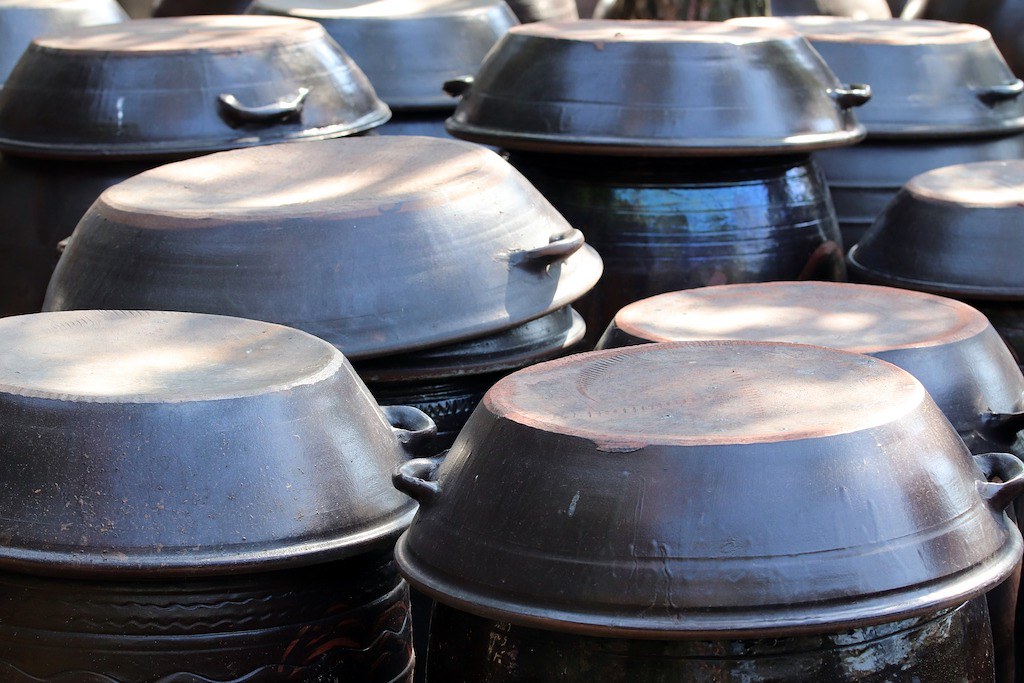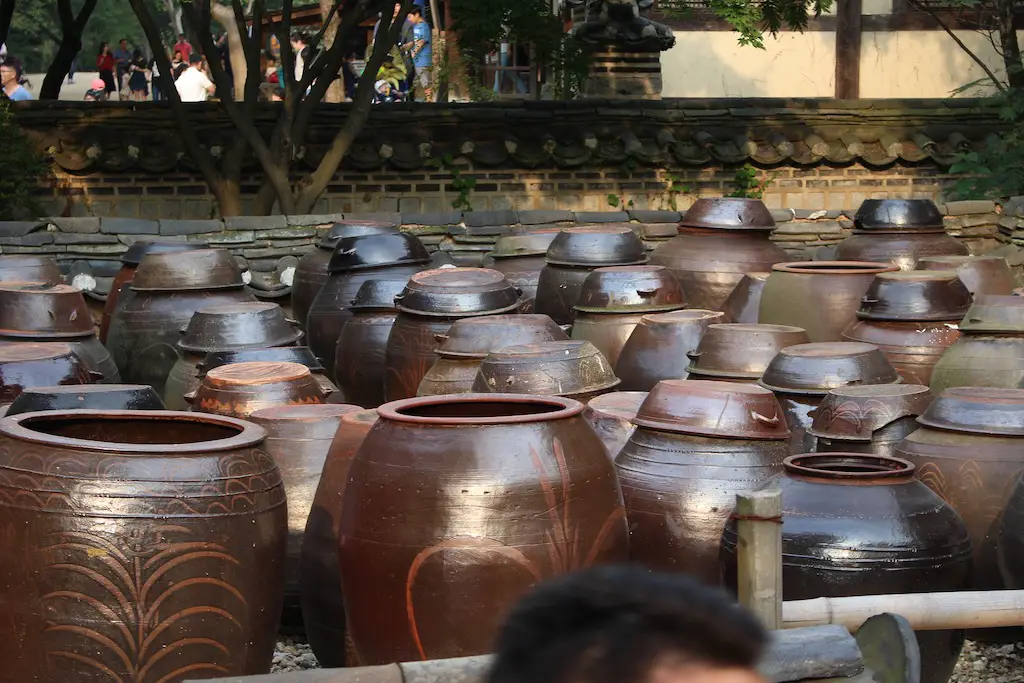This post may contain affiliate links. Please read my disclosure for details at the bottom of this page. As an Amazon Associate, I earn from qualifying purchases on this post about the Korean onggi (Korean earthenware pot).
For those new to Korean cooking, you may have seen or heard references to the Korean ‘onggi’ (옹기). In English, people translate the word ‘onggi’ as a ‘Korean earthenware pot.’
On the Korean peninsula, pottery has been used since prehistoric times for tableware and food storage–The earliest known onggi on the Korean peninsula dates back to around 4000 to 5000 BC. As such, the onggi is an important part of both North and South Korean traditional food culture. Here, we will take a deep dive into how people use the onggi, where to buy these pots, and how to maintain them.
What Is a Korean Onggi? What Do You Do With It?
As I stated above, the ‘onggi’ (옹기) is a type of traditionally made Korean earthenware pot (or Korean earthenware crock). The makers developed different sizes and styles of these pots as well as different uses. For example, people use them as tableware and storage containers.
On one hand, people traditionally used onggi to store ingredients such as rice or water. On the other hand, for centuries, people used these onggi pots as a type of storage container that helps to stimulate and promote the fermentation and preservation processes in certain types of food. Because of the material and kiln firing process used to make onggi, these pots have a more microporous structure than other porcelain. The porous and permeability creates an optimal environment for the healthy fermentation of foods.
You may have heard of people using these pots to make fermented food items such as:
- Doenjang: Soybean Paste
- Ganjang: Soy Sauce
- Gochujang: Hot Pepper Paste
- Makgeolli: Rice Wine Liquor
- Kimchi: Fermented Vegetables Such as Cabbage, Cucumber, and Radish

Lidded Korean Onggi. What Do They Contain?
Who Makes These Korean Earthenware Pots?
The onggi posts were made by a type of specially trained workmen called ‘onggijang’ (옹기장). These pottery makers were heavily influenced by the materials native to the regions as well as the climates. As a result, the type, shape, size, and manufacturing processes of these onggi vary greatly by region across North and South Korea.
Nowadays, as knowledge of traditional arts dwindles, these remaining onggi master craftsmen are considered national treasures. For many, it is an art passed down for generations.
Where Can I Buy an Earthenware Pot?
While you can find traditionally made onggi in South Korea, the cost of buying one and shipping it to another country can be very expensive.
If you do choose to buy one in South Korea, I recommend going to the Onggi Pottery Village in Ulsan, South Korea. This village is the largest producer of traditional Korean earthenware pots in Korea. Not only can you buy a pot there, but you can also participate in different activities run by professional artisans and craftsmen.
For those who desire to buy an onggi made in the United States, I recommend looking at Adam Field Pottery. Adam Field, a pottery artist out of Montana, had the unique opportunity to study in South Korea at a 7th generation onggi studio. The Kim Onggi pottery family is led by Kim Il-Maan who is a Korean National Cultural Treasure.
Finally, you can buy some of these pots from online store. For example, they do have a version available on Amazon!
How Do You Clean an Onggi?
When cleaning an onggi before and after use, do not use soap or any type of detergent. The soap will penetrate the microscopic holes, ruining the flavor and fermentation process of the food later stored in the container.
Instead, wash the interior of your pot with warm water. Scrub the pot until any food residue no longer remains. Then, whip the moisture with a towel and set it outside to fully dry for a few hours. Once again, you should let it air dry because water will be trapped in the porous holes.
Sometimes, your pot may continue to smell after scrubbing. This is perfectly natural. If you want to remove the smell, fill your onggi earthenware pot with hot water and let it sit for one or two days. Then, dump the water and let it dry in sunlight for another few days. Usually, this removes the smell. If it doesn’t, repeat the steps above.
Often, people in South Korea keep different onggi for different purposes. For example, you may want one pot for soy sauce, doenjang, and fish sauce. These have pungent smells that never fully go away. Then, you may have another pot for gochujang which naturally has a sweeter smell. Finally, you may want to buy another pot to make makgeolli. This way, the flavors and smells do not mingle!

A Traditional Korean Building–Onggi Sitting Outside the Door.
Do You Want An Earthenware Pot? Do You Already Own One?
In the end, do you want an onggi earthenware pot? If so, let us know in the comment section below. On the other hand, if you already own one, let us know what do you typically make with it.
If you would like to read more about cooking, you can find further recipes on our blog. We listed some of our favorite Carving A Journey Korean recipes below! For reference, many recipes are influenced by our blended Korean and Southern heritage. Also, we listed some of our gluten-free recommendations for Korean cooking!
Gluten-Free Korean Cooking:
- Our Favorite Gluten-Free Gochujang Brands
- Gluten-Free Soy Sauce Brands
- Different Gluten-Free Doenjang Brands
Carving A Journey Korean Recipes:
- Korean Braised Lotus Roots
- Tteokkochi (Korean Rice Cake Skewers)
- Jumeokbap (Handmade Korean Rice Balls)
- Bibimmyeon (Korean Spicy Cold Noodles); And
- Korean Banana Flavored Milk
If you have any questions or comments, you can also email us at [email protected].
And, finally, we would love to hear from you through our social media as well! You can follow us at @carvingajourney on Instagram, Twitter, Facebook, and Pinterest. Or, if you would like more articles like these, you can subscribe to our blog by joining our mailing list. We hope you enjoyed reading about the Korean onggi (Korean earthenware pot)! Thank you so much for stopping by!
Carving A Journey is a participant in the Amazon Services LLC Associates Program, an affiliate advertising program designed to provide a means for sites to earn advertising fees by advertising and linking to Amazon.com. Although we may earn commissions for our endorsement, recommendation, testimonial, and/or link to any products or services from this website, these opinions are my own and I fully support these products.

